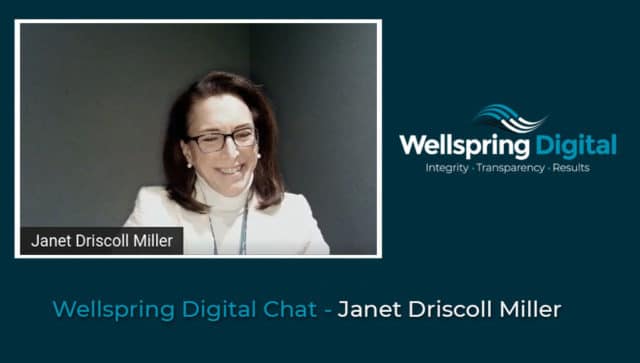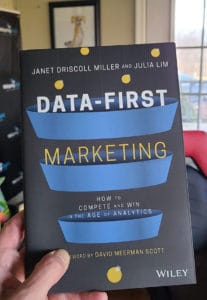I’ve known Janet for quite some time, and I can say that she is one of the smartest marketers I know. You’d have to be to write a kickass book called Data-First Marketing.
When I see Janet is a speaker where I’m speaking, I make sure to go to her session because I know it will be good. Her book, Data-First Marketing, was informative, inspirational, and somewhat frightening, in a good way.
We dive deep into her book and discuss…
- Analytics and digital transformation
- Aligning marketing and business goals
- Vanity metrics and tracking the right data
- Aligning content marketing with sales needs
- The future of digital marketing
- Privacy and Apple and cookies and Google and OMG!!!
No spoilers if you’re watching this, you’ll still need to read it, and you really should. Let’s do this…
Digital Transcription (Edited for Readability)
Introductions
Jon-Mikel Bailey: Hey kids, seen anything good on TV lately?
Sorry.
Hi. I’m Jon-Mikel Bailey and welcome to the Wellspring Digital Chat, where we go out we find some of the smartest people in digital marketing, and we con them and bribe them to come and talk to us to give us all of the goods, all of the tasty bits of knowledge that you need. And I mean, it’s a win-win.
They’re walking away with a pocket full of cash. And we’ve got a recorded session where we’ve got tons of great facts and stuff. Everybody wins. It’s, yeah. So anyway, I’ve known Janet for quite some time. And I can say that hands down one of the smartest marketers I know.
You kind of have to be smart to write a kick-ass book called Data-First Marketing. Believe me when I tell you it’s a page-turner, which when you see a title like data first marketing, you wouldn’t think it would be a page-turner, but it’s quite good.
Also, when I see Janet is a speaker, at any of the conferences where I’m speaking, I make sure to go to her session because I know him. I know I’m going to get some good stuff. So Janet, welcome.
Janet Driscoll Miller: Thank you.
Jon-Mikel Bailey: Thank you so much. Please take a moment and introduce yourself to these fine, folks.
Janet Driscoll Miller: Absolutely. So my name is Janet Driscoll Miller. I’m a co-author of the book Data-First Marketing, How to Compete and Win in the Age of Analytics. I’ve been running an agency now a digital marketing agency for 17 years company called Marketing Mojo. And we’re located in central Virginia in Charlottesville.
And this book really was a culmination of 17 years of experience with various clients across all industries, lots of really great. One of the things I think is great about working in agencies, you see a lot of different situations come up. And it really doesn’t matter what industry you’re in it, there are always new challenges and problems.
And that’s what inspired me to write the book was, let’s share some of the things we’ve learned and how we approach digital marketing at our agency, and what’s worked for us and for our clients.
Jon-Mikel Bailey: So I can agree on running an agency and seeing lots of different things. I know so much useless knowledge, I am a wizard at Trivial Pursuit. People are like “how do you know that? Well, I had a client who…”
Janet Driscoll Miller: You never know what you’re going to learn?
Jon-Mikel Bailey: Never a dull moment. So your book was informative. It was inspirational, and it was somewhat frightening, but in a good way. I want to pick your brain on a few things from the book. And I took the cover off, but here’s the book right here. Janet gave me the book, so full disclosure, but I’m not paid to say nice things about it.
But anyway, um, there are no spoilers if you’re watching this, I’m not going to give away the whole book here. So you’re gonna have to read it. And you really should. So, Janet, you’re ready, you’re ready to do this?
Analytics and Digital Transformation
Jon-Mikel Bailey: So your book, Data-First Marketing again, which you co-wrote with Julia Lim, surely gave my highlighter a workout. Actually, you can see, like, highlight, I defaced your book with my highlighter. One such passage that I highlighted was in reference to larger organizations struggling with making analytics pay off you.
“They treat analytics like a bandaid on top of current marketing operations.” You then talk about smaller firms being better able to transform themselves. And, you know, I can agree with that. But I also see so many examples where they are still either afraid to or they struggle with it. So what would be your advice to those smaller firms when they’re trying to tackle this whole analytics problem?
Janet Driscoll Miller: I just say, you know, start off slow, don’t pressure yourself too much. Really, any progress is better than no progress. And that’s really what I think. The book can be a bit intimidating, you know, thinking about all these steps to get to the end goal. But really any progress again is better than no progress.
Take your time and do it right because ultimately the challenge here is that if you rush yourself and you do not implement analytics correctly you’re going to be making judgments off of poor data, and bad data. And so you want to take your time and do it right. And you want to do it right as best you can from the beginning.
So when you’re a smaller group, and you’re growing, it’s a great opportunity to build things correctly from the ground up. When you’re a larger organization, that’s a bit more challenging. And there are more people involved a lot of times either to get different information or different things tagged or whatever it might be permissions.
And so I think this is an opportunity really, for smaller groups to really be able to capitalize. It is a great opportunity for them to be able to maneuver quickly, and be very agile and make those changes.
Jon-Mikel Bailey: So quick follow up to that. So Karl Hindle, who’s our CEO here, and also lifelong SEO and also kind of a nutjob. But in a good way. Karl always says “don’t trust the tools.” So do you agree with that when it comes to Analytics? Should people not be putting all of their analytics eggs into one data basket, so to speak?
Janet Driscoll Miller: I think you still are gonna have one analytics tool. There are different things you measure with different tools. And that’s really important to remember. So for instance, you have to also remember that different tools measure in different ways.
So I was having this conversation with a client who uses HubSpot. Right. And they were saying “my HubSpot leads don’t match the number of conversions or goals in Google Ads or Google Analytics.” And I had to say, “well, that’s because they measure differently.” When you’re a HubSpot contact, if it’s not measuring, if it’s only measuring new contacts, the conversions measuring every time someone comes through a contact in HubSpot, a person.
So if one person does five conversions on your site, analytics sees them as five conversions or five goals. But HubSpot still shows one person. So you have to remember how these tools measure differently. And keep that in mind and ask yourself what is it I want to know from the tool? That’s ultimately what you have to figure out.
Each tool can give you different types of information. What are you looking for, and which tool is best to give you that information? And another example, I have another client, we’ve been talking about using Google Search Console data, and Google Analytics data, well, you can’t mesh the two there, the way they pull their data is different.
And so it’s not comparing apples to apples if you put that data together. So it’s important to really have one data tool, one data set, and work from that data set. If you do not use a different data set for different reasons, that’s okay. But recognize and call out that these are not comparable, necessarily.
Data Analysis, Subjective or Objective?
Jon-Mikel Bailey: And I think you have, there’s another line that I highlighted here, where you say “to think that data analysis is objective is not realistic. Data must be understood in context.” And I think that’s huge.
Janet Driscoll Miller: Yeah, absolutely. I mean, really, and also thinking about how these tools measure as an example, Google Analytics, sometimes you’ll run into sampling data issues. I have some clients who have that issue. The same thing with Google Search Console, that tool is a great tool, but it’s a sample, and you don’t know how big the sample is.
So what if it’s the sample that’s on one end, that did a lot of activity on your site, versus the other end? The other 80%? Maybe that didn’t. So you’re really not sure exactly what the sample size is representative of. And so you have to be really careful about how much you’re taking from that data.
It can be great info and informative, but it may not be exact. And that’s the thing that we have to really keep in mind as marketers, is it can guide us, but we should not ever think that it’s absolute it anyway.
Jon-Mikel Bailey: Words by right there when you’re talking about data as far as I’m concerned.
Aligning Marketing and Business Goals
Jon-Mikel Bailey: Another passage from the book was specific to data-first marketing, but I think it applies across the board. And it reads “embracing data-first marketing starts with defining and aligning marketing goals with business goals.” And to me, this seems so you know, obvious, but it’s it keeps needing to be said over and over. So why is this? Why does it keep needing to be said?
Janet Driscoll Miller: I think in part what ends up happening, especially in larger organizations, but really in all organizations is that when we set goals at the top part of the business, the CEO, the CFO, the chief sales officer, all these folks setting these goals for the business and what the revenue should be what the lead generation should be.
Those goals don’t always get passed throughout the organization down to the lowest level, you know, the basic level, the foundational level of the organization. And so, as marketers, we know that we should drive more leads, we know we should drive more revenue. But we don’t always have a goal in mind, we don’t know that we should have this many leads, or, you know, this much revenue that we bring in.
And in addition to that, I find that a lot of the goals that are set up at the top, often are not based on realistic numbers. I find that regularly, like, I was working with a client the other day, and they said, “here are our lead generation goals.” And I said, “okay, but your budget is going to be the same as last year, and you want to triple your lease.”
It’s not, it’s not realistic, right? Maybe we’re setting up, or we want to, you know, have we had a B2B. And a lot of times you see in B2B that, like December is not usually a terribly good month for most B2B companies, from a lead generation or revenue perspective. And they had said that they’re going to get the most revenue for the year in December.
And I was like, we can see historically, that’s not what we see, you know, in your organization. So there’s, I think a lot of times to these goals, or even at the higher levels of the organization are aspirational, they want to do these things. But they don’t always base their decisions on these goals, based on actual data, and what may truly transpire in the coming year.
But passing those goals down throughout the organization is important. And so in the book, we talk a lot about how marketing needs a seat at the table. Marketing needs to be there to say, this is what we did, this is what we can do, and here’s how we can contribute to this business goal this year. And in part, I think, in the past, we haven’t been invited because we’re seen as the organization’s group that makes things look pretty.
And we did more than that we do a whole lot more than that. But we want to have that respect. And we want to be seen as an organization that is focused on these goals, and actual financial goals for the company, not just branding goals and things like that, which are also important. I don’t want to diminish those sure that but that certainly doesn’t necessarily directly speak to the bottom line of how the company performs.
Jon-Mikel Bailey: Yeah, it’s, you know, it’s one of those things where, and I’m sure you’ve seen this, I’ve been reading about it, about breaking down silos and getting marketing a seat at the table and all that stuff. And you know, people get busy and they lose sight of what’s important. And they think, oh, marketing, they’re gonna order the tchotchkes for the tradeshow table.
Janet Driscoll Miller: Exactly.
Jon-Mikel Bailey: You know, it’s so much more than that.
Vanity Metrics and Tracking the Right Data
Jon-Mikel Bailey: So another issue that kind of relates to that is, I want to talk about vanity. So we are forever telling marketers not to focus on so-called “vanity metrics,” such as likes and followers.
And you say in the book, and I’m paraphrasing a little bit here, you say, “it’s not about making something you’d be proud to submit for an award.” Amen, sister. “It’s about achieving business goals.”
How do you, as a marketer, how do you compete with that endorphin rush, that acceptance or praise or whatever, when trying to convince a marketer of this?
Janet Driscoll Miller: I think it’s a bit of a mindset shift. And it’s basically saying, “I’m going to get my endorphin rush by meeting that goal.” You know, we’re approaching right now, as you and I record this, we’re approaching the end of the first quarter. And I’m getting more relaxed, because, yeah, believe it or not, a couple of days away.
But I’ve gotten this endorphin rush because we’re coming to the finish line, are we going to meet these goals, I get real joy and jolt out of that for my clients to make sure that we’re meeting those goals and coming close. And I think, you know, also, if you reward teams for meeting those goals, then that can also be a real driver and get people are excited about the right direction.
So it’s not that you shouldn’t really still be embracing likes and shares and things like that. But ultimately, what should drive your team is meeting those business goals, and there are ways to obviously incentivize your team and get them excited and pumped up about meeting those goals.
Like I said, maybe it’s bonusing or maybe it’s a party, I mean, any kind of thing that you could do to try and get them excited about meeting those goals is going to bring your team on board as well.
Jon-Mikel Bailey: Well, and I also think the other thing that it does is it shows the value of marketing to the C suite. You know, so the C suite looks at marketing as a way to him improve the bottom line, as opposed to, you know, just a way to do neat-looking things.
Janet Driscoll Miller: Right? You don’t have to just make things look pretty, you can actually contribute to the success of the company. And, you know, ultimately, I think as marketers, we don’t always like to think of ourselves this way. But really, our job is to support the sales team, that is to support and drive sales.
And so we really have to be working with them closely, to really achieve those goals, and really making sure that they meet their goals, because when they meet their goals, we keep our jobs. So it’s really important for us to do that. And so you can’t work in a silo and do that. You have to be able to work with the rest of the organization and get them on board.
And that can be challenging, especially with the sales team, it’s sometimes, especially when you’re trying to get sales data, and you need it as a marketer to be able to say, well, what worked, what didn’t.
And if you’re working in your own little vacuum of just what you have in marketing data, and you don’t have the sales data, and you don’t see the outcomes of what you’re doing, it’s going to be very difficult for you to as a marketer, to know what really was successful and where your money is best spent.
Jon-Mikel Bailey: And that’s honestly, where a lot of the animosity starts to occur when there’s that disconnect.
Aligning Content Marketing with Sales Needs
Jon-Mikel Bailey: So my favorite thing is content marketing. And in the book, you talked a good bit about content. And I’m always surprised when business owners and/or marketing professionals don’t consider aligning their content with sales efforts, which is kind of you know, what we’re talking about here. So how much should sales goals influence your content marketing efforts? Or does it depend?
Janet Driscoll Miller: I think it should be driving your content marketing, to a very great degree, if not all, completely. In part, there are really two things I would think about when I think about how sales is driving marketing.
One is, specifically what industries and products you’re trying to promote that particular year. So like, different accounts that you may be going after, and so forth, what kind of content is best for them?
But the second is the different stages of the buyer cycle for those different industries and customers? And what are the pieces you need to create at each stage? And that can be very helpful to the sales team. You know, whether sales is distributing that content, or marketing is doing it via the website and through nurture programs, etc, is really somewhat irrelevant.
But ultimately, it’s how does this content move them to the next level? How does it get them at that next conversation going about a product or service that you’re selling? And so it really has got to be a driver of your content.
But to your point, I see a lot of folks in marketing who just create content in a vacuum, they don’t really talk to sales. And they think they know what’s best, because they looked at maybe some vanity metrics, what got shared what got likes, that’s really not driving the bottom line.
Jon-Mikel Bailey: So it’s funny you say that because I am the CDMO here at Wellspring Digital. So not only am I worried about content marketing, but I am also worried about business development. So, you know, the silos don’t exist in my brain. It’s one brain. And, and so maybe I take it for granted.
But yeah, it’s super important.
Janet Driscoll Miller: Yeah, absolutely.
The Future of Digital Marketing
So you wrap up the book with a quote from playwright, George Bernard Shaw, which is “progress is impossible without change, and those who not cannot change their minds cannot change anything.” So the digital marketing landscape is constantly changing. So crystal ball time, do you have any predictions based on all the data you’ve been crunching and staring at lately, that you would like to share with us?
Janet Driscoll Miller: I think what I’d like to share is what I think is going to be the biggest challenge right now. Okay, that is you probably heard the news about GA (Google Analytics) 4 and I think that’s…
Jon-Mikel Bailey: CMOs are losing their minds right now.
Janet Driscoll Miller: For good reason. By the way, let me tell you that. I don’t know if anybody knows this, but in GA 4 currently. You cannot, they group organic traffic together, organic search traffic under the default channel groupings. And if you look deeper in the default channel groupings, it also includes docs.google.com, classroom.google.com, and things that are not search engines. And you can’t edit it.
You can’t unlike Universal Analytics where you can either create your own channel groupings, or you can edit the default channel grouping. You cannot do that in GA 4 at this time. So I actually have a client that this is what came up, they’re an educational software client, they’re an SEO client of ours. And we told them don’t move to GA 4 at this time.
This is before the announcement because it’s going to, by default, include a lot of things as organic traffic, that are organic traffic, that are just kids going into their Chromebooks clicking on a link from their teacher to go to the app. That’s not a search. That’s not organic search. It doesn’t define if we were successful or not.
So there’s a lot of challenge, I think, facing us as marketers with this migration, and especially SEOs, especially digital marketers. And I really, I’m really hopeful that Google recognizes there are some challenges here, they need to fix with this tool, prior to it becoming our sole tool on July 1, 2023. That is, that’s the hard and fast date so…
Jon-Mikel Bailey: Clearly, Danny Sullivan listens to and John Mueller listens to SEOs or at least replies back.
Janet Driscoll Miller: I think there’s gonna be a reason, you know, you and I have seen each other a lot at Digital Summits. And, you know, I go and talk at Digital Summits across the country about analytics. And when I would tell people just anecdotally, like I might have a room of 100 people there. And I would just randomly pull them and say, just curious how many of you have implemented GA 4? And maybe two people out of 100 had raised their hands?
Jon-Mikel Bailey: I think you did that one down in Charlotte.
Janet Driscoll Miller: Yeah, remember, there are very few people are doing it. And there’s a reason for that. It’s very challenging for marketers to learn this new tool, it’s very different, how it does things, if it’s not fun, it’s really bad. It’s just different. And so you’re asking everybody to drop everything, implement this new tool, and by the way, relearn from a usability perspective, how your reports are going to be generated.
And then come to find out not even as accurately as you’d like them to be. So there are definitely a lot of challenges for the marketer, and I’m working on some presentations and some pieces right now to help people migrate. Because I think that is really going to be a big challenge facing all of us. And if we don’t start that now, come July 1 next year, you won’t have your data. So you got to really start that progress, that progression. Now with GA 4 and, unfortunately…
Jon-Mikel Bailey: In my mind, 2023 is like 10 years away.
Janet Driscoll Miller: I’d like it to be but it’s not. It’s coming fast.
Jon-Mikel Bailey: Man. I’m going to be 50 in three months. How did that happen? It’s crazy.
Janet Driscoll Miller: I woke up early.
Jon-Mikel Bailey: Thank you. Thank you.
Privacy and Apple and Cookies and Google and OMG!!!
Jon-Mikel Bailey: So I want to sneak in an extra question here. I just want to get your take on all the hoopla about privacy, with with Apple’s announcements and and just with, you know, the third party cookie issues and just see, you know, where you stand on that, if you don’t mind.
Janet Driscoll Miller: So my issue with privacy in the United States in particular, is more that we don’t have laws that protect our individual citizens, right? We don’t have GDPR here, we don’t have other privacy laws that exist, like in the UK and so forth.
Jon-Mikel Bailey: I can’t imagine why. I mean, I watched the Senate hearings, and all those senators seemed so knowledgeable about the internet.
Janet Driscoll Miller: Yeah, it’s so wonderful that we all know everything about the internet. It’s shocking to me that we cannot get to that point as a country from a privacy perspective for protecting privacy. However, I’m not necessarily a fan of removing cookie tracking. Like, I don’t feel that cookie tracking is that invasive.
I do see Google’s point, when you use Google Analytics, as an example, one of the rules of using that tool is that you can’t have personally identifiable information. So you can put someone’s email address into Google Analytics for your tracking. And I think those kinds of rules are very important.
I’ve seen Google break those rules, by the way, I’ve seen it with some of their tools where they inadvertently have collected data that they shouldn’t have collected. I’ve seen it with my own kids. I know you have have kids, teenagers, and they use Chromebooks. And I had to go to our school system and say, “Hey, Google is showing my kid ads. That’s not okay.”
It’s things like that. So there are definitely some issues with privacy. I don’t feel like cookies are our biggest problem, though, quite frankly. And I do think it’s going to be a challenge for us as marketers as we go to this cross-device world.
Yeah, we’re, in some ways, getting rid of cookies and coming up with new ways of tracking is going to be helpful, because so many people are using multiple devices anymore to do their research and purchase cycle that to really understand the customer journey. You need to be able to go cross-device, but cookies don’t allow you to do that today.
So I think there’s great, I have great optimism for what’s coming in the future. But I do think that the emphasis on cookies is a little bit…
Jon-Mikel Bailey: Misguided?
Janet Driscoll Miller: Yeah, exactly. Yeah, I don’t think it’s bad. And I do think too, like, cookies offer a lot of really good things that people are thinking about. Like the fact that I don’t have to log in every single time to something. I can have my login saved and things like that, those things are helpful. And so if we got rid of cookies altogether, it’s gonna take away some things I think that users actually really enjoy as well.
Jon-Mikel Bailey: I don’t want to live in a world without cookies. I mean, when I’m having a bad day, a nice warm chocolate chip cookie is just that’s gonna make it for me. So absolutely.
Well, Janet, thank you so much for being here. Again, read her book, Data-First Marketing, highly, highly, highly recommended.
I’ll put a link below in the transcription. So thank you so much for being here.
Janet Driscoll Miller: Also I want to let you know that I’m willing to give a free book away if anyone would like to sign up for a chance to win a free book. If you go to https://bit.ly/wellspringbook. You can sign up on the Internet for a drawing for a free copy of the book. If you want to put that link in then people…
Jon-Mikel Bailey: I will, yeah. Janet, you’re the best.
Janet Driscoll Miller: Oh, thank you. Thanks for having me.
Jon-Mikel Bailey: Thank you so much. And yeah, this is good stuff. So awesome.
Janet Driscoll Miller: I’ll see a Digital Summit soon.
Jon-Mikel Bailey: Yay, yupper, I’ll be there.
Janet Driscoll Miller: Bye.
Jon-Mikel Bailey: Bye!







